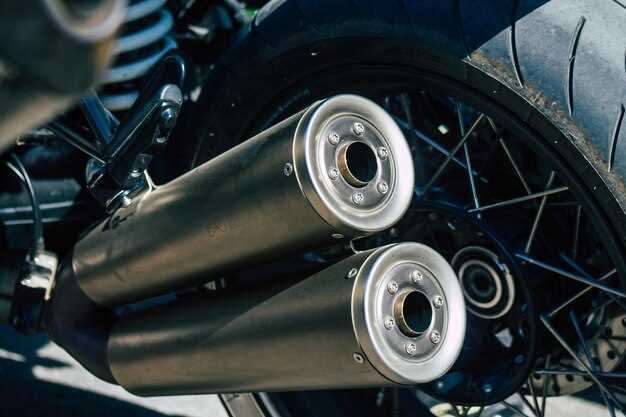

Selecting the appropriate exhaust system for your motorcycle is a crucial decision that directly impacts its overall performance. The right system can enhance power output, improve throttle response, and optimize fuel efficiency, while a poorly matched exhaust may lead to reduced performance and even engine damage. Understanding the various options available and how they affect your ride is essential for any motorcycle enthusiast.
When choosing an exhaust system, it’s important to consider the specific needs of your bike and riding style. Various systems, such as slip-ons, full systems, and high-performance options, offer different benefits that can cater to diverse preferences. A full system may provide the best performance gains, while a slip-on could suffice for riders seeking a balance between aesthetics and slight performance enhancement.
Additionally, factors such as weight reduction, sound characteristics, and emission regulations should also be taken into account. The right exhaust system can transform your motorcycle’s character and ensure it meets your performance expectations, all while keeping within local legal requirements. Through careful consideration and research, you can select the exhaust system that aligns perfectly with your riding experience.
Understanding Exhaust System Types and Their Impact on Performance
Choosing the right exhaust system for your motorcycle is crucial as it directly influences performance, sound, and aesthetics. There are several types of exhaust systems, each designed with specific characteristics and performance benefits.
The two primary categories of exhaust systems are slip-on and full systems. Slip-on exhaust systems replace the muffler section of the stock setup while retaining the stock header pipes. This option is popular for riders looking to improve sound and slight performance gains without extensive modifications. They are generally easier to install and provide a cost-effective solution for enhancing aesthetics and exhaust flow.
Full exhaust systems comprise both the header pipes and the muffler. These systems allow for more significant modifications in exhaust flow, leading to improved horsepower and torque. Full systems typically reduce backpressure, enhancing engine efficiency, especially in tuned or modified motorcycles. However, they require a more complex installation and a bigger investment.
Another crucial type is the 2-into-1 exhaust system. This design merges two header pipes into a single pipe before exiting. This configuration can significantly enhance torque delivery and is often favored by cruiser and touring motorcycle riders. It provides a cleaner look and can improve performance at lower RPMs.
In addition to system type, materials also play a key role in performance. Stainless steel, titanium, and carbon fiber are common materials used in exhaust construction. Stainless steel is durable and reasonably priced, while titanium is lightweight and offers excellent heat resistance–ideal for performance racing. Carbon fiber is another lightweight option that adds a modern look but may not be as durable for everyday use.
Finally, while selecting an exhaust system, consider the intended use of the motorcycle. If you’re focused on street riding, a system that enhances low-end torque may be beneficial. For track or performance riding, a free-flowing system might be the better choice. Understanding the impact of different exhaust system types helps in making an informed decision that aligns with your motorcycle’s performance goals.
Factors to Consider for Sound Preference and Ride Experience

When selecting an exhaust system for your motorcycle, sound preference greatly influences both the performance of your bike and your overall ride experience. The sound produced by an exhaust system can range from quiet and subtle to loud and aggressive, and this choice should align with your personal preferences and riding style.
Volume and Tone: The volume of the exhaust note can significantly impact your riding experience. A louder exhaust can enhance your presence on the road but might become tiresome during long rides. Consider whether you prefer a deep, throaty growl or a higher-pitched scream, as each tone conveys a different character and reflects your style.
Resonance: Resonance occurs when sound waves amplify at certain frequencies. Some exhaust systems are designed to minimize resonance, leading to a smoother and more enjoyable ride. A system with high resonance might deliver an aggressive sound but can compromise comfort on longer trips. Take the time to listen to various systems and determine which resonates best with you.
Backpressure: The design of the exhaust affects backpressure, which is crucial for engine performance. Systems with less restrictive components can enhance horsepower but may alter the sound quality. Striking a balance between optimal performance and the desired sound is essential for achieving the ride experience you seek.
Material: The material of the exhaust system can also affect the sound. Stainless steel typically produces a sharper tone, while titanium may provide a richer and deeper sound. Additionally, consider how the material impacts weight. A lighter exhaust can improve handling and overall performance, enhancing your riding experience.
Legality and Compliance: Be aware of local noise regulations, as some areas impose limits on exhaust sound levels. Selecting an exhaust that meets these requirements will ensure that you enjoy your ride without legal issues and contribute to a safer riding environment.
Ultimately, evaluating these factors will help you choose an exhaust system that aligns with your sound preference and enhances your ride experience, ensuring both enjoyment and performance on the road.
Evaluating Compatibility with Your Motorcycle Model and Year

When selecting an exhaust system for your motorcycle, it is essential to evaluate its compatibility with your specific model and year. Not all exhaust systems are universally compatible; variations in design, engine configuration, and mounting points can significantly impact performance and fitment.
Start by consulting your motorcycle’s manufacturer specifications to find the recommended exhaust systems for your model. Many manufacturers provide a list of compatible exhaust options in their owner’s manual or on their official website. This information ensures that the selected system will fit correctly without the need for extensive modifications.
Consider factors such as engine size and type when assessing compatibility. For example, a dual-sport motorcycle may require a different exhaust system compared to a sportbike, even if both share the same engine displacement. The layout of the exhaust pipes, muffler position, and required brackets can vary significantly between different models and years, influencing both installation and performance outcomes.
Additionally, verify whether your motorcycle has undergone any modifications that might affect exhaust compatibility. Changes in the engine, such as upgraded performance parts or adjusted mounting points, can necessitate a different exhaust system than what was originally intended for your bike. Consulting with a knowledgeable dealer or motorcycle mechanic can provide insight into potential compatibility issues that may arise from aftermarket alterations.
Lastly, consider the legal aspects and noise regulations in your region, which can dictate what types of exhaust systems are permissible. Confirm that the chosen exhaust system complies with local noise ordinances and emissions standards. This will not only ensure your motorcycle remains street legal but also maximize its performance potential while maintaining compatibility with your model.
